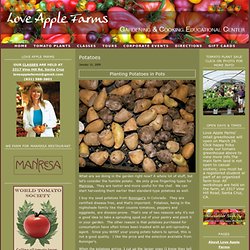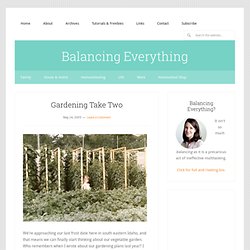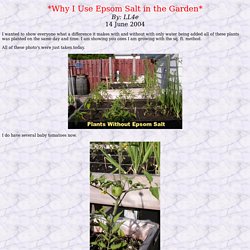

Lawn Reform Coalition. Potatoes. What are we doing in the garden right now?

A whole lot of stuff, but let's consider the humble potato. We only grow fingerling types for Manresa. They are tastier and more useful for the chef. We can start harvesting them earlier than standard-type potatoes as well. I buy my seed potatoes from Ronniger's in Colorado. When the potatoes arrive, I cut up the larger ones (I know they tell you not to, but hear me out here). All the tubers get put in a single layer in seedling trays (open at the bottom for air flow).
I like to grow potatoes in 15 gallon pots. First, we disinfect our stash of used pots with a mixture of one part bleach to 10 parts water. We then place only 4 inches of potting soil into the bottom of each pot. Once the soil is in the pots, we simply push five tubers into each one, about two inches under. The pots are then placed in our large unheated hoophouse and watered well.
These gorgeous Purple Peruvians were photographed freshly pulled last spring here at the farm. Gardening Take Two. We’re approaching our last frost date here in south eastern Idaho, and that means we can finally start thinking about our vegetable garden.

Who remembers when I wrote about our gardening plans last year? I told y’all about how my parents kept an incredible garden using the Jacob Mittleider method. You can read that post and view the pictures right here. In short, the Mittleider method combines the best features of soil-based gardening and hydroponic gardening, but without hydroponic expense! It’s a complete, easy-to-follow plan that eliminates guesswork and ensures success anywhere: an apartment patio, a city yard, a country lot, or a farm. The method is based on maximum utilization of space, time, and resources. I’ve received a lot of questions during the past year on how Square Foot Gardening compares and I really couldn’t say. Here are the garden plans I drew up last year. Last year we built 14 grow boxes; 8 inches deep, 4 feet wide, and 8 feet long.
Why I Use Epsom Salt in the Garden. *Why I Use Epsom Salt in the Garden*By: LL4e14 June 2004 I wanted to show everyone what a difference it makes with and without with only water being added all of these plants was planted on the same day and time.

I am showing you ones I am growing with the sq. ft. method. All of these photo's were just taken today. I do have several baby tomatoes now. However now the non Epsom salt plants will be fed it also this was only to show those what a difference it makes. In the Garden House Plants Mix one teaspoon per gallon of water and feed to the plants every two to four weeks. Garden startup Sprinkle approximately one cup per 100 square feet. (10’x10’) and mix into soil before planting. Tomatoes Apply one tablespoon per foot of height for each plant every two weeks. Roses Apply one teaspoon per foot of height for each plant every two weeks.
Evergreens, Azaleas, Rhododendrons Apply one tablespoon per nine square feet (3’x3’) over the root zone every two to four weeks. Plant companions. 1-2-3- weeeee! let's build a garden... 5 Easy to Grow Mosquito-Repelling Plants. As the outdoor season approaches, many homeowners and outdoor enthusiasts look for ways to control mosquitoes.

With all the publicity about the West Nile virus, mosquito repelling products are gaining in popularity. But many commercial insect repellents contain from 5% to 25% DEET. There are concerns about the potential toxic effects of DEET, especially when used by children. Children who absorb high amounts of DEET through insect repellents have developed seizures, slurred speech, hypotension and bradycardia. There are new DEET-free mosquito repellents on the market today which offer some relief to those venturing outdoors in mosquito season. Here are five of the most effective mosquito repelling plants which are easy to grow in most regions of the US: 1.
Citronella is the most common natural ingredient used in formulating mosquito repellents. Citronella is a perennial ‘clumping’ grass which grows to a height of 5 – 6 feet. 2. Horsemint leaves can be dried and used to make herbal tea. 11 Ways to Control Weeds Without Chemicals - Article. Science Of Gardening: Feed: Plants and people alike, we all have a need to feed.
Happy Photon. Contemporary photography eZine. RogersPlants. RHS Plant Selector. The Metropolitan Museum of Art, New York.